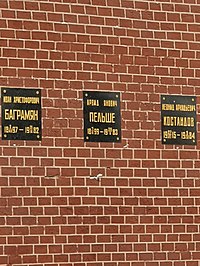Arvīds Pelše
Arvīds Pelše | |
|---|---|
Арвид Пельше | |
Politburo | |
| In office 8 April 1966 – 29 May 1983 | |
| Personal details | |
| Born | 7 February 1899 |
| Profession | Politician, historian |
Arvīds Pelše (
Career
Pelše was born into a peasant family, in Mazie farm near
He was a lecturer and political commissar in the Red Army from 1919 to 1929. In 1931, he graduated from the history department of the Moscow Institute of the Red Professoriat, and between 1931 and 1933, he was a graduate student in the institute. At the same time, he was an instructor at the Institute of Party History at the Central School of
In 1958, he traveled to Denmark to attend the 20th Congress of the Communist Party of Denmark. July 1959 to November 1959 marked the purge of all nascent nationalism from the Communist Party of Latvia—about 2,000 of the party leadership and activists were stripped of their posts and privileges.
The Soviets elevated Pelše to First Secretary, replacing the purged Kalnbērziņš on 25 November 1959. In January 1960, Pelše promptly denounced his former (purged) associates for deviating from "the right path in carrying out Leninist nationality policy".[3] From that point forward, the First Secretaries of the Latvian SSR were servile party functionaries, as first embodied by Pelše, whom Latvians regarded as symbols of submissiveness to the Soviets.[4][5]
Pelše was appointed as member of the
In 1963, Pelše headed a commission nicknamed the "Pelše Commission", which investigated the assassination of Sergei Kirov. The commission finished its work in 1967.[6]
Pelše served as First Secretary of the Latvian SSR until 15 April 1966. At the 23rd Party Congress in 1966, Pelše addressed his colleagues as follows:
- "We will never permit anyone to interfere in our internal affairs but will conduct a determined struggle against any imperialist interference in the affairs of other countries and peoples."
On 7 November 1975, Pelše gave a speech in the ceremony commemorating the 58th anniversary of the October Revolution. In his address, Pelše confirmed continuing Soviet support for "fighters for freedom" and "the patriots in Angola."[7]
He was rewarded for his faithful service, being selected by the 23rd Party Congress for full membership to the
Death and legacy

Pelše's health was failing in his last years. When he did not attend the funeral of Leonid Brezhnev in November 1982, rumors spread he had died, but a few days later, on 23 November, he appeared in a session of the Supreme Soviet. Another absence which was noticed by the media was in the ceremony marking the centennial of the death of Karl Marx, on 31 March 1983, one month before he died.[8]
He suffered from
Pelše wrote some works on the history of the CPSU, on the history of the revolutionary movement in Latvia, anti-capitalist nationalists, the socialist and communist construction in the country.
He was twice awarded with
Pelše was married three times. He had two children from the first marriage: a daughter, Beruta (died), and son, Arvik (died during World War II). One son from the second marriage, Tai, (was born in 1930) - a pensioner, and did not support any contacts with his father after the 3rd marriage. The third wife of Pelše was Lidiya, the ex-wife of Stalin's secretary Alexander Poskrebyshev. From 1966 until his death, he lived at 15 Spiridonovka Street. A commemorative plaque was placed in the front of the building.
References
- ^ LVVA. Ф. 235, Оп. 7, Д. 110, Л. 78 об-79.
- ^ a b Who's Who in Russia Since 1900, Martin McCauley
- ^ Soviet Disunion
- ^ Dreifelds, Juris, Latvia in Transition, Cambridge University Press, 1996.
- ^ Bogdan, Henry, Histoire des peuples de l’ex-URSS [History of the Peoples of the former USSR], Perrin, Paris, 1993.
- ^ Who Killed Kirov?: The Kremlin's Greatest Mystery, 2000
- ^ Angola, national liberation and the Soviet Union, Dr. Daniels Papp
- ^ UPI, March 30, "Eight Politburo members gathered today in the Bolshoi Theater to mark the centennial of the death of Karl Marx"
- ^ Medical assessment that appeared in Soviet newspapers on 31 May 1983
